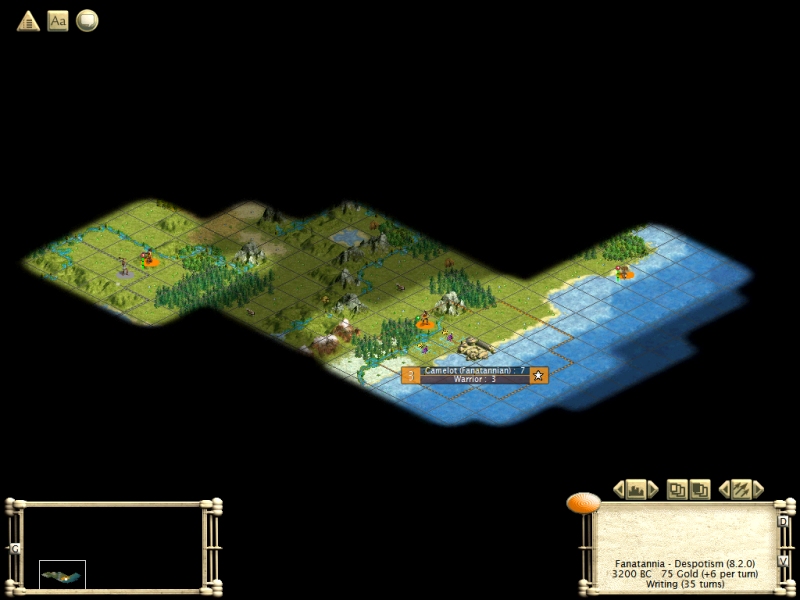MOTH
Emperor
We must decide as a nation what we want our settlement density to be during general expansion. At this point this is to cover the next 30-50 turns. During this time we should get between 4 and 8 additional settlers. Tactical discussions will include settlement order and site selection (dot maps).
Discussion can be found here: http://forums.civfanatics.com/showthread.php?t=113150
A map of our currently known territory is at the bottom of this post.
For the purposes of the poll please refer to the following definitions:
Very Low Density: Allowing the full 21 tiles per city.
Low Density: Anything allowing more than 14 (but less than 20) workable tiles per city.
Medium Density: Allowing between 8-13 workable tiles per city.
High Density: Allowing 7 or less tiles per city.
Options:
1. Very Low density in High-food areas, low to medium density in low-food or coastal areas
High food areas should have 20 tiles available. Low food areas (tundra, desert) should use overlapping tiles. Exceptions should be made in coastal areas to allow for some overlap..
2. Low Density. Allow for tile changes over the course of the game.
3. Medium to low Density, coastal caution.
13 tiles per city in all areas and be careful with initial coastal placement as they could make harbors necessary thus eating into the Seafaring commercial bonus.
4. Low to Medium inland. Medium to High density on the coast.
A tight build on the coast and a looser build inland with good terrain to maximize seafaring trait.
5. Medium Density using rough CxxC pattern.
Cities no closer than 3 tiles away from each other.
6. Medium Density if fresh water, high density if not.
13 Tiles to support 12 citizens if fresh water, 7 tiles to support 6 citizens if aqueduct needed.
7. Other - Please include a post with what you want.
8. Abstain.
Poll Interpretation: This will provide guidance to the Director of Expansion for use in the tactical discussions and decisions. The options are in a general spectrum from less dense to more dense. It is expected that the mean of the votes will be used in designing the tactical plans. If for some reason there is heavy support (25+%) on both ends of the spectrum then poll will be invalidated and discussions will be expanded before re-polling.
This will be open for 4 days, but the Director of Expansion may use the voting trends to start Tactical Plans. So, vote early and vote often

Discussion can be found here: http://forums.civfanatics.com/showthread.php?t=113150
A map of our currently known territory is at the bottom of this post.
For the purposes of the poll please refer to the following definitions:
Very Low Density: Allowing the full 21 tiles per city.
Low Density: Anything allowing more than 14 (but less than 20) workable tiles per city.
Medium Density: Allowing between 8-13 workable tiles per city.
High Density: Allowing 7 or less tiles per city.
Options:
1. Very Low density in High-food areas, low to medium density in low-food or coastal areas
High food areas should have 20 tiles available. Low food areas (tundra, desert) should use overlapping tiles. Exceptions should be made in coastal areas to allow for some overlap..
2. Low Density. Allow for tile changes over the course of the game.
3. Medium to low Density, coastal caution.
13 tiles per city in all areas and be careful with initial coastal placement as they could make harbors necessary thus eating into the Seafaring commercial bonus.
4. Low to Medium inland. Medium to High density on the coast.
A tight build on the coast and a looser build inland with good terrain to maximize seafaring trait.
5. Medium Density using rough CxxC pattern.
Cities no closer than 3 tiles away from each other.
6. Medium Density if fresh water, high density if not.
13 Tiles to support 12 citizens if fresh water, 7 tiles to support 6 citizens if aqueduct needed.
7. Other - Please include a post with what you want.
8. Abstain.
Poll Interpretation: This will provide guidance to the Director of Expansion for use in the tactical discussions and decisions. The options are in a general spectrum from less dense to more dense. It is expected that the mean of the votes will be used in designing the tactical plans. If for some reason there is heavy support (25+%) on both ends of the spectrum then poll will be invalidated and discussions will be expanded before re-polling.
This will be open for 4 days, but the Director of Expansion may use the voting trends to start Tactical Plans. So, vote early and vote often



